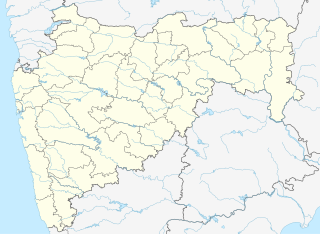
Konkan, also known as the Konkan Coast, is a rugged section of the western coastline of India. Konkan proceeds from the north at Damaon in the Gulf of Cambay, extends southwards all along the western seaside land areas of Maharashtra and Goa, and meets the Canara coast at the northern edge of Karwar district of Karnataka.

Konkani is an Indo-Aryan language spoken by the Konkani people, primarily along the western coastal region (Konkan) of India. It is one of the 22 Scheduled languages mentioned in the 8th schedule of the Indian Constitution and the official language of the Indian state of Goa. The first Konkani inscription is dated 1187 A.D. It is a minority language in Karnataka, Maharashtra, Kerala, Gujarat and Dadra and Nagar Haveli and Daman and Diu.
The Pamir languages are an areal group of the Eastern Iranian languages, spoken by numerous people in the Pamir Mountains, primarily along the Panj River and its tributaries.
The Western Pahari languages are a group of Northern Indo-Aryan languages spoken in the western parts of the Himalayan range, predominantly in the Indian state of Himachal Pradesh, but also in parts of Jammu and Uttarakhand.
Malvani is a dialect of Konkani with significant Marathi influences and loanwords. Though Malvani does not have a unique script, script of Devnagari language is used. Devanagari is used by most of the speakers. Malvani is very popular language used for sarcastic newspaper articles and local folk stage dramas known as Dashavatar.
Konkani people are an ethno-linguistic community who inhabit and originate the Konkan region of south-western India, and speak various dialects of the Konkani language. They also reside in Kanara, Malabar, Goa and Damaon, and Maharashtra.

Malvanpronunciation (help·info) is a town and taluka in Sindhudurg District, the southernmost district of Maharashtra State, India, well known for the historically important Sindhudurg Fort. Malvan taluka consists of villages such as Angane Wadi Masure, Achra, Khalchi Devli, Jamdul, Juva, Pankhol, Talasheel and Sarjekot. The main occupation here is fishing and agriculture. The staple diet of the local people is fish curry and rice. The town produces Alphonso mangoes and is also known for sweets such as Malvani Khaja made from gram-besan flour and coated jaggery as well as Malvani Ladoos. Other sweets that attract tourists are Konkani meva, Aambawadi, Fanaspoli, dry fruits, Kajuwadi, Naralachya Wadya, and Malvani Masale.
Konkani Muslims are an ethnoreligious subgroup of the Konkani people primarily living in the Konkan region of western India, who practise Islam. Indigenous Muslims from the districts of Sindhudurg, Ratnagiri, Raigad, Mumbai (Bombay) city and suburb, and Thane are generally regarded as Konkani Muslims. Karwari Konkani Muslims of Bhatkal, situated at the southern border of Konkan in Uttara Kannada district of Karnataka are known as Nawayaths

Maharashtra is the third largest state of India. It has a long history of Marathi saints of Varakari religious movement, such as Dnyaneshwar, Namdev, Chokhamela, Eknath and Tukaram which forms the one of bases of the culture of Maharashtra or Marathi culture. Maharashtra had huge influence over India under the 17th-century king Shivaji of the Maratha Empire and his concept of Hindavi Swarajya which translates to self-rule of people.
The Marathi-Konkani languages are the mainland Southern Indic languages, spoken in Maharashtra and the Konkan region of India.

Chitpavani is a dialect of the Konkani language as spoken by the Chitpavan Brahmin community residing chiefly in Konkan area. Chitpavans, as they are known today, evolved as a community in the Ratnagiri district of Maharashtra, India. This region lies on the western coast of the country. Chitpavans in Ratnagiri speak a peculiar dialect called Chitpavani, which was spoken in the district until the 1950s, but as time went on, people in the district adopted Marathi as their language.
Thakri, or Thakuri is a dialect of Marathi spoken by about 100,000 people of the Adivasi community in Raigad district, Maharashtra, India. It has traces of a non-Marathi substratum. It is classified as a part of the Maharashtrian Konkani group of dialects according to ISO 639.

Kudaldeshkar Gaud Brahmin is a community hailing from the western coast of India, residing in the Konkan division of Maharashtra and Goa. This community is also known as Kudaldeshkar Aadya Gaud Brahmin, Kudaldeshkar and sometimes Kudalkar Brahmins. They speak Marathi, Malwani dialect of Konkani.

Canarese Konkani is a minority language spoken by the Konkani people of Karnataka and in some parts of Kerala.
Konkani is a southern Indo-Aryan language belonging to the Indo-European family of languages spoken in the Konkan coast of India. It has approximately 3.6 million speakers.
The Konkani language agitations were a series of protests and demonstrations that happened in the Indian state of Goa during the post-Independence period. The agitations involved several mass protests, riots, student& political movements in Goa, concerning the uncertain future and the official status of the Konkani language, prevailing at the time in territory of Goa and Damaon in the Indian Republic.

The Goan Muslims are a minority community who follow Islam in the western Indian coastal state of Goa. They are native to Goa, unlike recent Muslim migrants from Karnataka. They are commonly referred as Moir by Goan Catholics and Hindus. Moir is derived from the Portuguese word mour (Moors). The Portuguese called them Mouros because they were called Mouros and later generalized as Mouros.
The Phudagi language, also known as Vadvali, is a language or dialect of the Marathi–Konkani group. This language is spoken by Panchkalshi and Chaukalshi communities residing in Palghar, Vasai localities.
Berar-Deccan Marathi, is a possible language of the Marathi–Konkani group, or perhaps just a regional dialect of Marathi. Glottolog reports that it is closely related to Varhadi-Nagpuri. (Sub)dialects are Bijapuri and Kalvadi. These have been counted among the Marathi dialects, and it is not clear just how distinct they are from standard Marathi, with the distinct Deccani language perhaps being Deccani Urdu.







